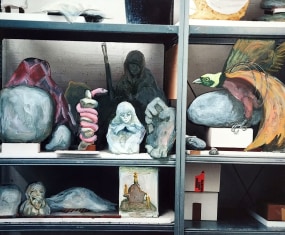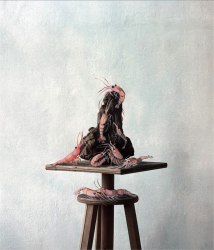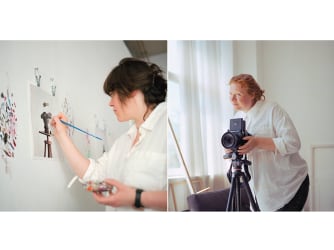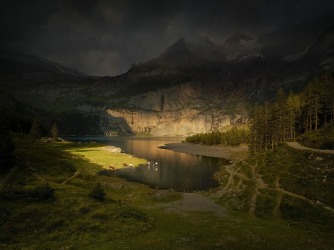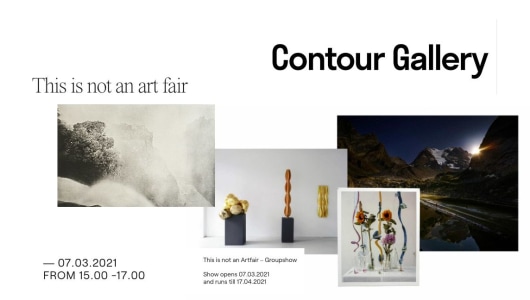Marie Pop is a mixed media artist who often combines painting and photography, but who also doesn’t shy away from sculpture, installation and performance. Their early work focussed much on poetic, slightly dark-humoured storytelling.
In her debut exhibition, The Opulent Temple of the Lost Paradise (2020), which explored the loss of lives against the backdrop of the Corona pandemic, Marie Pop embarked on a long artistic journey exploring the depth of emotions. In the following year, The Lost Wonders of the Future Paradise illuminated the prospects of hope and a new beginning, ultimately garnering tremendous success at Art Rotterdam 2021 with all the artworks nearly selling out. Now, Le Studio Perdu unveils Marie Pop’s new chapter, delving into pressing matters within the art world while retaining the pure joy of aesthetics and provoking thought in viewers.
Marie Pop defies categorisation, moving between the realms of minimalism and expressionism while embodying a fluid identity of a woman, a man, and everything in between. As an artist, her versatility knows no bounds, extending to the mediums of painting, photography, sculpture, installation, and even performative art. As she guides you behind the scenes, immersing you in her creative process, paradoxically, you find yourself standing on the stage.
In her debut exhibition, The Opulent Temple of the Lost Paradise (2020), which explored the loss of lives against the backdrop of the Corona pandemic, Marie Pop embarked on a long artistic journey exploring the depth of emotions. In the following year, The Lost Wonders of the Future Paradise illuminated the prospects of hope and a new beginning, ultimately garnering tremendous success at Art Rotterdam 2021 with all the artworks nearly selling out. Now, Le Studio Perdu unveils Marie Pop’s new chapter, delving into pressing matters within the art world while retaining the pure joy of aesthetics and provoking thought in viewers.
Marie Pop defies categorisation, moving between the realms of minimalism and expressionism while embodying a fluid identity of a woman, a man, and everything in between. As an artist, her versatility knows no bounds, extending to the mediums of painting, photography, sculpture, installation, and even performative art. As she guides you behind the scenes, immersing you in her creative process, paradoxically, you find yourself standing on the stage.
Artworks
Articles
Media
Highlights
Recommendations
Collections
Shows
Market position
CV
Articles on Marie Pop
Media
Short preview interview Marie Pop just before Art Rotterdam 2021
Shows
Market position
Marie Pop’s Le Studio Perdu – Lost Stories Found in the Lost Studio
Marie Pop explores the duplicity of meanings through her multi-layered art – whether it is the mediums or the message. Le Studio Perdu presents to you what has been lost, whether it be the works that get lost in the process of creation, the lost stories of art making, or the identities and craftsmanship of women that has been lost in history.
The inherent ambiguity within Marie Pop’s artworks paves the way for reading and interpretation. In general, interpretations aren’t fixed within the images but rather are dependent on how they are viewed in connection with one another and with other texts. Through the literary technique “intertextuality,” Marie Pop creates artworks that are abundant in allusions, meanings, and messages that appear not only through the subject but also through the genre of her art. While Marie Pop’s works are autonomous creations in their own right, they also serve as a homage to the art and stories of historical female figures.
Throughout history, the biased and patriarchal nature of the art world has marginalised women and their artistic contributions. This inequality persists today, evident in various aspects such as the significant pay gap between female and male artists. A report highlights that the inequality between women and men in the visual arts extends beyond remuneration, mainly as a result of (under-)representation and unconscious bias. In other words, the female artists were not taken as seriously and their contributions were deemed of less significance. As a response to these issues, the feminist art movement emerged in the 1960s with the goal to reclaim the rightful positions of women in the art world. The movement continues to battle such inequality that persists to this day.
In this regard, Linda Nochlin, an American art historian, pointed out in one of the first feminist art scholarly texts which came out during the time the feminist art movement was taking shape, “Why Have There Been No Great Women Artists?” According to Nochlin, the fault does not lie in being a woman in the physical or biological sense, but rather in the institutional, educational, and cultural barriers that create an oppressive structure. We exist in a world filled with meanings and signs that often overlook women.
Feminist art movement emerged at the end of the 60s as the Second Wave of Feminism was taking place earlier in the same decade. The first wave of feminist art addressed the feminine experience, pushing boundaries with its radical and sometimes “abject” expressions, including the use of vaginal imagery and menstrual blood. Pioneering female artists made significant strides in capturing public attention through their provocative works within this genre. This type of art not only shocks but also informs its viewer by incorporating historical elements into the work. Judy Chicago’s The Dinner Party does both. The work is a triangular dining table set consisting of porcelain plates with raised central motifs that are based on vulvar forms. This long-term installation commemorates the important female public figures by means of dinner seats on a triangular table for 39 mythical and historical famous women.
Equally rich in historical references, yet with a contrasting effect to being shocking, Le Studio Perdu offers the audience, rather, a sense of soothing subtlety. With surrealism and expressionism as the mainstay of her art throughout the years, Marie Pop communicates to her audience with a gentle but meaningful touch that is imbued with forceful ideals. These popular genres have historically served as a platform for female artists to liberate themselves from societal myths and constraints, making them the foundation of Marie Pop’s series and a testament to the feminist art movement. Transcending harsh graphics that are usual for the topic, instead, Marie Pop’s work exudes a romantic air that leaves a lasting, and rather positive, impression on the viewer.
Le Studio Perdu brings the overshadowed female figures out into the light. Behind the household names of, for instance, Auguste Rodin, Pablo Picasso, and Edward Hopper are Camille Claudel, Françoise Gilot, Dora Maar, and Josephine Hopper. These women, unappreciated during their time, are remarkable artists in their own right. In the present day, it is important to give prominence to these names and celebrate their significant contributions. Many of the modern artists within the movement have taken it upon themselves to challenge and reframe art history, reshaping our understanding of femininity and its portrayal in the art world – Marie Pop has joined this ride.
Prior to the movement, female figures were merely known for the association with their overshadowing male counterparts. One of the most tragic stories barely told was that of Camille Claudel, an assistant who was to be a lover of Rodin. Sakountala, featured in Le Studio Perdu series, is one of the masterful sculptures by Claudel. Marie Pop’s work encapsulates both the essence of the female artist and the creative process behind Claudel’s masterpiece. In the case of Claudel, her life story resonates with the experiences of many women, both in her time and unfortunately, even today. One can sadly say that it remains as such for many women even today. More often than not, as with Claudel, we still hear about abusive relationships and power dynamics where males assume a position of “superiority” and females are seen as “subordinate.” Likewise, the ongoing challenges of limited opportunities reflect Claudel’s own struggle to achieve recognition as a female artist.
Guerrilla Girls (1985), featured also within Le Studio Perdu, aims to subvert the dominant narrative of the male-dominated art world by exposing the concealed story and the fundamentally unfair. Guerrilla impact through, like Marie Pop, the utilisation of intertextuality. By appropriating established works created by male artists, twisting and reshaping them, they convey new meanings that subvert the original works. For instance, “The Guerrilla Girls Talk Back” features posters depicting a gorilla-headed nude that appears in Jean-Auguste-Dominique Ingres’ La Grande Odalisque and Warhol’s banana composed in the shape of female genitalia. Here we no longer see what was thought to be “beautiful” but rather confronted with what society has conditioned us to perceive as “ugly.” Is it really so? The gorilla, the female part?
Marie Pop not only sheds light on forgotten female artists but also adds another layer to the existing feminist discourse by amplifying it within her new series. That said, Marie Pop’s art can be admired for its pleasing aesthetics. One does not need to be informed to appreciate the beauty Le Studio Perdu has to offer. Because, after all, down the road of multiplicity and ambiguity, the series explores the realm of artistic identity, blurring boundaries and delving into questions of gender, the role of the artist, and the timeless nature of an art piece. After all, the word “duplicity” itself has double meanings – the other meaning being “deception.” Le Studio Perdu can also deceive you into believing what may seem obvious.
Marie Pop explores the duplicity of meanings through her multi-layered art – whether it is the mediums or the message. Le Studio Perdu presents to you what has been lost, whether it be the works that get lost in the process of creation, the lost stories of art making, or the identities and craftsmanship of women that has been lost in history.
The inherent ambiguity within Marie Pop’s artworks paves the way for reading and interpretation. In general, interpretations aren’t fixed within the images but rather are dependent on how they are viewed in connection with one another and with other texts. Through the literary technique “intertextuality,” Marie Pop creates artworks that are abundant in allusions, meanings, and messages that appear not only through the subject but also through the genre of her art. While Marie Pop’s works are autonomous creations in their own right, they also serve as a homage to the art and stories of historical female figures.
Throughout history, the biased and patriarchal nature of the art world has marginalised women and their artistic contributions. This inequality persists today, evident in various aspects such as the significant pay gap between female and male artists. A report highlights that the inequality between women and men in the visual arts extends beyond remuneration, mainly as a result of (under-)representation and unconscious bias. In other words, the female artists were not taken as seriously and their contributions were deemed of less significance. As a response to these issues, the feminist art movement emerged in the 1960s with the goal to reclaim the rightful positions of women in the art world. The movement continues to battle such inequality that persists to this day.
In this regard, Linda Nochlin, an American art historian, pointed out in one of the first feminist art scholarly texts which came out during the time the feminist art movement was taking shape, “Why Have There Been No Great Women Artists?” According to Nochlin, the fault does not lie in being a woman in the physical or biological sense, but rather in the institutional, educational, and cultural barriers that create an oppressive structure. We exist in a world filled with meanings and signs that often overlook women.
Feminist art movement emerged at the end of the 60s as the Second Wave of Feminism was taking place earlier in the same decade. The first wave of feminist art addressed the feminine experience, pushing boundaries with its radical and sometimes “abject” expressions, including the use of vaginal imagery and menstrual blood. Pioneering female artists made significant strides in capturing public attention through their provocative works within this genre. This type of art not only shocks but also informs its viewer by incorporating historical elements into the work. Judy Chicago’s The Dinner Party does both. The work is a triangular dining table set consisting of porcelain plates with raised central motifs that are based on vulvar forms. This long-term installation commemorates the important female public figures by means of dinner seats on a triangular table for 39 mythical and historical famous women.
Equally rich in historical references, yet with a contrasting effect to being shocking, Le Studio Perdu offers the audience, rather, a sense of soothing subtlety. With surrealism and expressionism as the mainstay of her art throughout the years, Marie Pop communicates to her audience with a gentle but meaningful touch that is imbued with forceful ideals. These popular genres have historically served as a platform for female artists to liberate themselves from societal myths and constraints, making them the foundation of Marie Pop’s series and a testament to the feminist art movement. Transcending harsh graphics that are usual for the topic, instead, Marie Pop’s work exudes a romantic air that leaves a lasting, and rather positive, impression on the viewer.
Le Studio Perdu brings the overshadowed female figures out into the light. Behind the household names of, for instance, Auguste Rodin, Pablo Picasso, and Edward Hopper are Camille Claudel, Françoise Gilot, Dora Maar, and Josephine Hopper. These women, unappreciated during their time, are remarkable artists in their own right. In the present day, it is important to give prominence to these names and celebrate their significant contributions. Many of the modern artists within the movement have taken it upon themselves to challenge and reframe art history, reshaping our understanding of femininity and its portrayal in the art world – Marie Pop has joined this ride.
Prior to the movement, female figures were merely known for the association with their overshadowing male counterparts. One of the most tragic stories barely told was that of Camille Claudel, an assistant who was to be a lover of Rodin. Sakountala, featured in Le Studio Perdu series, is one of the masterful sculptures by Claudel. Marie Pop’s work encapsulates both the essence of the female artist and the creative process behind Claudel’s masterpiece. In the case of Claudel, her life story resonates with the experiences of many women, both in her time and unfortunately, even today. One can sadly say that it remains as such for many women even today. More often than not, as with Claudel, we still hear about abusive relationships and power dynamics where males assume a position of “superiority” and females are seen as “subordinate.” Likewise, the ongoing challenges of limited opportunities reflect Claudel’s own struggle to achieve recognition as a female artist.
Guerrilla Girls (1985), featured also within Le Studio Perdu, aims to subvert the dominant narrative of the male-dominated art world by exposing the concealed story and the fundamentally unfair. Guerrilla impact through, like Marie Pop, the utilisation of intertextuality. By appropriating established works created by male artists, twisting and reshaping them, they convey new meanings that subvert the original works. For instance, “The Guerrilla Girls Talk Back” features posters depicting a gorilla-headed nude that appears in Jean-Auguste-Dominique Ingres’ La Grande Odalisque and Warhol’s banana composed in the shape of female genitalia. Here we no longer see what was thought to be “beautiful” but rather confronted with what society has conditioned us to perceive as “ugly.” Is it really so? The gorilla, the female part?
Marie Pop not only sheds light on forgotten female artists but also adds another layer to the existing feminist discourse by amplifying it within her new series. That said, Marie Pop’s art can be admired for its pleasing aesthetics. One does not need to be informed to appreciate the beauty Le Studio Perdu has to offer. Because, after all, down the road of multiplicity and ambiguity, the series explores the realm of artistic identity, blurring boundaries and delving into questions of gender, the role of the artist, and the timeless nature of an art piece. After all, the word “duplicity” itself has double meanings – the other meaning being “deception.” Le Studio Perdu can also deceive you into believing what may seem obvious.
CV
Exhibitions & Art Fairs
2020
KunstRAI 2020, Amsterdam (NL)
Art fair, represented by Contour Gallery, Rotterdam (NL)
‘The Opulent Temple of the Lost Paradise’
Contour Gallery, Rotterdam (NL)
Solo exhibition
‘Publieke Werken Rotterdam’
Group exhibition in public space, Rotterdam (NL)
2018
‘Marie Pop presents Marie Pop’
De Aanschouw, Rotterdam (NL)
Solo exhibition in Rotterdam’s tiniest gallery
2017
‘Holland’
TENT, Rotterdam (NL)
Group exhibition as part of ‘Holland’, a project by Mark Lotterman
‘Leviathan’
Willem Twee Kunstruimte, ‘s-Hertogenbosch (NL)
Solo exhibition
2016
Art The Hague ‘Special Editions’ (NL)
Art fair, represented by Galerie Vonkel, Den Haag (NL)
‘Holland’
Group exhibition as part of ‘Holland’, a project by Mark Lotterman
‘Holland’
Quay Arts Institute, Isle of White (UK)
Group exhibition as part of ‘Holland’, a project by Mark Lotterman
Publications:
Contribution to ‘Holland – the book’, as part of the project by Mark Lotterman
Other:
2020
PPR-contribution, a grant from CBK Rotterdam to develop the new series ‘The Opulent Temple of the Lost Paradise’
2019
Auction participation and exhibition ‘De Aanschouw’
De Aanschouw & TENT, Rotterdam (NL)
2020
KunstRAI 2020, Amsterdam (NL)
Art fair, represented by Contour Gallery, Rotterdam (NL)
‘The Opulent Temple of the Lost Paradise’
Contour Gallery, Rotterdam (NL)
Solo exhibition
‘Publieke Werken Rotterdam’
Group exhibition in public space, Rotterdam (NL)
2018
‘Marie Pop presents Marie Pop’
De Aanschouw, Rotterdam (NL)
Solo exhibition in Rotterdam’s tiniest gallery
2017
‘Holland’
TENT, Rotterdam (NL)
Group exhibition as part of ‘Holland’, a project by Mark Lotterman
‘Leviathan’
Willem Twee Kunstruimte, ‘s-Hertogenbosch (NL)
Solo exhibition
2016
Art The Hague ‘Special Editions’ (NL)
Art fair, represented by Galerie Vonkel, Den Haag (NL)
‘Holland’
Group exhibition as part of ‘Holland’, a project by Mark Lotterman
‘Holland’
Quay Arts Institute, Isle of White (UK)
Group exhibition as part of ‘Holland’, a project by Mark Lotterman
Publications:
Contribution to ‘Holland – the book’, as part of the project by Mark Lotterman
Other:
2020
PPR-contribution, a grant from CBK Rotterdam to develop the new series ‘The Opulent Temple of the Lost Paradise’
2019
Auction participation and exhibition ‘De Aanschouw’
De Aanschouw & TENT, Rotterdam (NL)
Free Magazine Subscription
Articles, interviews, shows & events. Delivered to your mailbox weekly.
